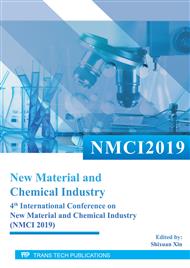[1]
A H Hall, B H Rumack, M D Denver, Clinical toxicology of cyanide, UAEM/IRIEM Research Symposium on Toxicology, San Francisco, USA (1986).
Google Scholar
[2]
D W Boening, C M Chew, A critical review: general toxicity and environmental fate of three aqueous cyanide ions and associated ligands, Water, Air, & Soil Pollution. 109 (1999) 67-79.
Google Scholar
[3]
D B Donato, O Nichols, H Possingham, et al., A critical review of the effects of gold cyanide-bearing tailings solutions on wildlife, Environment International, 33 (2007) 974-984.
DOI: 10.1016/j.envint.2007.04.007
Google Scholar
[4]
D Hoffmann, I Hoffmann, K El-Bayoumy, The less harmful cigarette: a controversial issue. a tribute to ernst l. wynder, Chemical Research Toxicology. 14 (2001) 767-790.
DOI: 10.1021/tx000260u
Google Scholar
[5]
J P Xie, H M Liu, M X Zhu, et al., Development of a novel hazard index of mainstream cigarette smoke and its application on risk evaluation of cigarette products, CORESTA Congress, Shanghai, China (2008), plenary Session, Invited Paper.
Google Scholar
[6]
M I Arthur, L W David, US Patent 4091822 (1978).
Google Scholar
[7]
M J Chinn, P R Norman, WO 9911358 (1999).
Google Scholar
[8]
P Li, M Hajaligol, E J Shin, et al., US Patent 20070113862 (2007).
Google Scholar
[9]
W John, J Thaddeus, US Patent 20070295345 (2007).
Google Scholar
[10]
P Branton, A H Lu, F Schüth, The effect of carbon prestructure on the adsorption of cigarette smoke vapour phase compounds, Carbon, 47 (2009) 1005-1011.
DOI: 10.1016/j.carbon.2008.12.003
Google Scholar
[11]
B S Girgis, S S Yunis, A M Soliman, Characteristics of activated carbon from peanut hulls in relation to conditions of preparation, Materials Letters. 57(2002) 164-172.
DOI: 10.1016/s0167-577x(02)00724-3
Google Scholar
[12]
Z A AL-Othman, R Ali, M Naushad, Hexavalent chromium removal from aqueous medium by activated carbon prepared from peanut shell: Adsorption kinetics, equilibrium and thermodynamic studies, Chemical Engineering Journal. 184 (2012) 238–247.
DOI: 10.1016/j.cej.2012.01.048
Google Scholar
[13]
W Q Cai, Z L Li, J H Wei, et al., Synthesis of peanut shell based magnetic activated carbon with excellent adsorption performance towards electroplating wastewater, Chemical Engineering Research and Design. 140 (2018) 23-32.
DOI: 10.1016/j.cherd.2018.10.008
Google Scholar
[14]
P D Johnson, M A Watson, J Brown, et al., Peanut hull pellets as a single use sorbent for the capture of Cu(Ⅱ) from wastewater, Waste Management. 22 (2002) 471-480.
DOI: 10.1016/s0956-053x(01)00036-8
Google Scholar
[15]
O M Yaghi, H Li, T L Groy, Construction of porous solids from hydrogen-bonded metal complexes of 1,3,5-benzenetricarboxylic acid, Journal of the American Chemical Society. 118 (1996) 9096-9101.
DOI: 10.1021/ja960746q
Google Scholar
[16]
H L Guo, Y Z Zhu, S Wang, et al., Combining Coordination Modulation with Acid–Base Adjustment for the Control over Size of Metal–Organic Frameworks, Chemistry of Materials. 24 (2012) 444-450.
DOI: 10.1021/cm202593h
Google Scholar
[17]
C Chen, N J Feng, Q R Guo, et al., Surface engineering of a chromium metal-organic framework with bifunctional ionic liquids for selective CO2, adsorption: Synergistic effect between multiple active sites, Journal of Colloid and Interface Science. 521 (2018) 91-101.
DOI: 10.1016/j.jcis.2018.03.029
Google Scholar
[18]
A Maleki, T Kari, M Aghaei, Fe3O4@SiO2@TiO2-OSO3H: an efficient hierarchical nanocatalyst for the organic quinazolines syntheses, Journal of Porous Materials, 24 (2017) 1481-1496.
DOI: 10.1007/s10934-017-0388-z
Google Scholar
[19]
A Maleki, J Rahimi, Synthesis of dihydroquinazolinone and octahydroquinazolinone and benzimidazoloquinazolinone derivatives catalyzed by an efficient magnetically recoverable GO-based nanocomposite, Journal of Porous Materials, 25 (2018) 1789-1796.
DOI: 10.1007/s10934-018-0592-5
Google Scholar
[20]
A Maleki, Z Hajizadeh, R F Haji, Eco-friendly functionalization of magnetic halloysite nanotube with SO3H for synthesis of dihydropyrimidinones, Microporous and Mesoporous Materials, 259 (2018) 46-53.
DOI: 10.1016/j.micromeso.2017.09.034
Google Scholar
[21]
A Maleki, Z Hajizadeh, V Sharifi, et al., A green, porous and eco-friendly magnetic geopolymer adsorbent for heavy metals removal from aqueous solutions, Journal of Cleaner Production, 215 (2019) 1233-1245.
DOI: 10.1016/j.jclepro.2019.01.084
Google Scholar
[22]
GB 1886.232-2016, Food additive Sodium carboxymethyl cellulose, National Healthy Commission of the People's Republic of China (2016).
Google Scholar
[23]
P J Sun, S Yang, X H Sun, et al., Functional Porous Carboxymethyl Cellulose/Cellulose Acetate Composite Microspheres: Preparation, Characterization, and Application in the Effective Removal of HCN from Cigarette Smoke, Polymers. 11 (2019) 181.
DOI: 10.3390/polym11010181
Google Scholar
[24]
C Nie, L Zhao, B Peng, et al., China Patent 200982968Y (2007).
Google Scholar
[25]
X H Sun, J Zhu, Y P Wang, et al., Dual Functional Modification of Mesoporous Material and its Effect on Hydrogen Cyanide Reduction in Cigarette Smoke, Tobacco Science & Technology. 48 (2015) 27-33.
Google Scholar
[26]
G Wulfsberg, Inorganic Chemistry, University Science Books (2000).
Google Scholar


